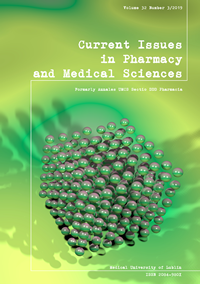Microbiological evaluation of 10 commercial probiotic products available in Poland
DOI:
https://doi.org/10.2478/cipms-2019-0022Keywords:
probiotics, viable bacterial count, lactobacilli, bifidobacteriaAbstract
The aim of this study was to analyze the quality of 10 commonly available commercial probiotic products used in Poland. These items were tested for the total viable bacterial count, and for identifying the isolated strains. This was performed using the Polymerase Chain Reaction method. The results showed that five of the tested products had not the applicable number of viable bacteria declared by manufacturer. Moreover, not all declared probiotic strains were found in three of the tested products during analyses. It is clear that a regular control of probiotic products needs be introduced that can guarantee its beneficial properties.
References
1. Report WHO/FAO. Probiotics in food: Health and nutritional properties and guidelines for evaluation. Rome 2006. Food and Agriculture Organization of the United Nations: 1-29.
2. Hove H, Nørgaard H, Mortensen PB. Lactic acid bacteria and the human gastrointestinal tract. Eur J Clin Nutr. 1999;53:339-50.
3. Szajewska H, Mrukowicz JZ. Probiotics in the treatment and prevention of acute infectious diarrhea in infants and children: a systematic review of published randomized, double-blind, placebo-controlled trials. J Pediatr Gastroenterol Nutr. 2001;33(Suppl 2):S17-25.
4. Chapman CM, Gibson GR, Rowland I. Health benefits of probiotics: are mixtures more effective than single strains? Eur J Nutr. 2011; 50:1-17.
5. Pereira DI, McCartney AL, Gibson GR. An in vitro study of the probiotic potential of a bile-salt-hydrolyzing Lactobacillus fermentum strain, and determination of its cholesterol-lowering properties. Appl Environ Microbiol. 2003;69:4743-52.
6. Lu L, Walker WA. Pathologic and physiologic interactions of bacteria with gastrointestinal epithelium. Am J Clin Nutr. 2001;3:1124-1130S.
7. Zawistowska-Rojek A, Zaręba T, Mrówka A, Tyski S. Assessment of the microbiological status of probiotic products. Pol J Microbiol. 2016;65:97-104.
8. Drago L, Rodighiero V, Celeste T, Rovetto L, De Vecchi E. Microbiological evaluation of commercial probiotic products available in the USA in 2009. J Chemother. 2010;22:373-7.
9. Song Y, Kato N, Liu C, Matsumiya Y, Kato H, Watanabe K. Rapid identification of 11 human intestinal Lactobacillus species by multiplex PCR assays using group- and species-specific primers derived from the 16S-23S rRNA intergenic spacer region and its flanking 23S rRNA. FEMS Microbiology Letters. 2000;187:167-73.
10. Motevaseli E, Shirzad M, Raoofian R, Hasheminasab SM, Hatami M, Dianatpour M et al. Differences in vaginal lactobacilli composition of iranian healthy and bacterial vaginosis infected women. Iranian Red Crescent Medical Journal. 2013;15:199-206.
11. Szajewska H, Fordymacka A, Banaszkiewicz A. Microbiological qualitative and quantitative analysis of probiotic products registered in Poland for medicinal purposes (pilot study). Pediatria Polska 2002; LXXVII: 941-4.
12. Szajewska H, Fordymacka A, Bardowski J, Górecki RK, Mrukowicz JZ, Banaszkiewicz A. Microbiological and genetic analysis of probiotic products licensed for medicinal purposes. Med Sci Monit 2004;10:346-50.
13. Aureli P, Fiore A, Scalfaro C, Casale M, Franciosa G. National survey outcomes on commercial probiotic food supplements in Italy. Int J Food Microbiol. 2010;137:265-7.
14. Drisko J, Bischoff B, Giles C, Adelson M, Rao RV, McCallum R. Evaluation of five probiotic products for label claims by DNA extraction and polymerase chain reaction analysis. Dig Dis Sci. 2005;50:1113-7.
15. Huys G, Vancanneyt M, D’Haene K, Vankerckhoven V, Goossens H, Swings J. Accuracy of species identity of commercial bacterial cultures intended for probiotic or nutritional use. Res Microbiol. 2006;157:803-10.
16. Weese JS. Evaluation of deficiencies in labeling of commercial probiotics. Can Vet J. 2003;44:982-3.
17. Milazzo I, Speciale A, Musumeci R, Fazio D, Blandino G. Identification and antibiotic susceptibility of bacterial isolates from probiotic products available in Italy. New Microbiol. 2006;29:281-91.
18. Morgan CA, Herman N, White PA, Vesey G. Preservation of micro-organisms by drying; a review. J Microbiol Methods. 2006;66:183-93.
Downloads
Published
Issue
Section
License
Copyright (c) 2019 Autors

This work is licensed under a Creative Commons Attribution-NonCommercial-NoDerivatives 3.0 Unported License.


